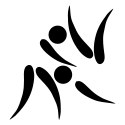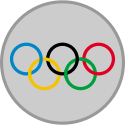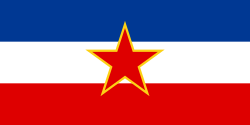Olympische Sommerspiele 1976/Judo
| Judo bei den Olympischen Sommerspielen 1976 | |
|---|---|
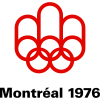 | |
 | |
| Information | |
| Austragungsort | |
| Wettkampfstätte | Vélodrome olympique |
| Nationen | 46 |
| Athleten | 136 (136 |
| Datum | 26.–31. Juli 1976 |
| Entscheidungen | 6 |
| ← München 1972 | |
Bei den XXI. Olympischen Sommerspielen 1976 in Montreal fanden sechs Judo-Wettbewerbe für Männer statt. Austragungsort war das Vélodrome olympique.
Bilanz
Medaillenspiegel
| Platz | Land | Gesamt | |||
|---|---|---|---|---|---|
| 1 | 3 | 1 | 1 | 5 | |
| 2 | 2 | 2 | 1 | 5 | |
| 3 | 1 | – | – | 1 | |
| 4 | – | 1 | 2 | 3 | |
| 5 | – | 1 | 1 | 2 | |
| 6 | – | 1 | – | 1 | |
| 7 | – | – | 1 | 1 | |
| – | – | 1 | 1 | ||
| – | – | 1 | 1 | ||
| – | – | 1 | 1 | ||
| – | – | 1 | 1 | ||
| – | – | 1 | 1 | ||
| – | – | 1 | 1 |
Medaillengewinner
| Konkurrenz | Gold | Silber | Bronze |
|---|---|---|---|
| Leichtgewicht | |||
| Halbmittelgewicht | |||
| Mittelgewicht | |||
| Halbschwergewicht | |||
| Schwergewicht | |||
| Offene Klasse |
Ergebnisse
Leichtgewicht (bis 63 kg)
| Platz | Land | Sportler |
|---|---|---|
| 1 | Héctor Rodríguez | |
| 2 | Chang Eun-kyung | |
| 3 | Felice Mariani | |
| József Tuncsik | ||
| 5 | Erich Pointner | |
| Marian Standowicz | ||
| 7 | José Gomes | |
| Brad Farrow | ||
| 18 | Alexander Leibkind |
Datum: 30. Juli 1976
29 Teilnehmer aus 29 Ländern
Halbmittelgewicht (bis 70 kg)
| Platz | Land | Sportler |
|---|---|---|
| 1 | Wladimir Newsorow | |
| 2 | Kōji Kuramoto | |
| 3 | Marian Tałaj | |
| Patrick Vial | ||
| 5 | Lee Chang-seon | |
| Vacinuff Morrison | ||
| 7 | Juan Carlos Rodríguez | |
| John Van Hoek | ||
| 9 | Thomas Hagmann | |
| 11 | Dietmar Hötger |
Datum: 29. Juli 1976
27 Teilnehmer aus 27 Ländern
Mittelgewicht (bis 80 kg)
| Platz | Land | Sportler |
|---|---|---|
| 1 | Isamu Sonoda | |
| 2 | Waleri Dwoinikow | |
| 3 | Slavko Obadov | |
| Park Young-chul | ||
| 5 | José Luis de Frutos | |
| Fred Marhenke | ||
| 7 | Paul Buganey | |
| Süheyl Yeşilnur | ||
| 11 | Jurek Jatowitt | |
| 19 | Detlef Ultsch |
Datum: 28. Juli 1976
27 Teilnehmer aus 27 Ländern
Halbschwergewicht (bis 93 kg)
| Platz | Land | Sportler |
|---|---|---|
| 1 | Kazuhiro Ninomiya | |
| 2 | Ramas Charschiladse | |
| 3 | Jürg Röthlisberger | |
| David Starbrook | ||
| 5 | Cho Jea-ki | |
| Dietmar Lorenz | ||
| 7 | An Ung-nam | |
| Abdoulaye Djiba | ||
| 12 | Arthur Schnabel | |
| 18 | Paul Büchel | |
| Johann Pollak |
Datum: 27. Juli 1976
32 Teilnehmer aus 32 Ländern
Schwergewicht (über 93 kg)
| Platz | Land | Sportler |
|---|---|---|
| 1 | Sergei Nowikow | |
| 2 | Günther Neureuther | |
| 3 | Allen Coage | |
| Sumio Endō | ||
| 5 | Güsemiin Dschalaa | |
| Mihály Petrovszky | ||
| 7 | Abdoulaye Koté | |
| Radomir Kovačević | ||
| 10 | Klaus Wallas | |
| 17 | Hans-Jakob Schädler |
Datum: 26. Juli 1976
19 Teilnehmer aus 19 Ländern
Offene Klasse
| Platz | Land | Sportler |
|---|---|---|
| 1 | Haruki Uemura | |
| 2 | Keith Remfry | |
| 3 | Cho Jea-ki | |
| Schota Tschotschischwili | ||
| 5 | Jorge Portelli | |
| Jean-Luc Rougé | ||
| 7 | Günther Neureuther | |
| Pak Jong-gil | ||
| 9 | Klaus Wallas | |
| 16 | Dietmar Lorenz | |
| Hans-Jakob Schädler |
Datum: 31. Juli 1976
23 Teilnehmer aus 23 Ländern
Weblinks
- Judo bei den Olympischen Sommerspielen 1976 in der Datenbank von Sports-Reference (englisch; archiviert vom Original)
- Offizielle Ergebnisse der Sommerspiele 1976 (PDF, 22,7 MB)
Auf dieser Seite verwendete Medien
Pictograms of Olympic sports - Judo. This is unofficial sample picture. Images of official Olympic pictograms for the 1948 Summer Olympics and all Summer Olympics since 1964 can be found in corresponding Official Reports.
Flag of Canada introduced in 1965, using Pantone colors. This design replaced the Canadian Red Ensign design.
Unicode Geschlechtersymbolder
Autor/Urheber: maix¿?, Lizenz: CC BY-SA 2.5
A gold medal with the olympic rings inside
Autor/Urheber: maix¿?, Lizenz: CC BY-SA 2.5
A silver medal with the olympic rings inside
Autor/Urheber: maix¿?, Lizenz: CC BY-SA 2.5
A bronze medal with the olympic rings inside
Variant version of a flag of Japan, used between January 27, 1870 and August 13, 1999 (aspect ratio 7:10).
(c) I, Cmapm, CC BY-SA 3.0
The flag of the Soviet Union (1955-1991) using a darker shade of red.
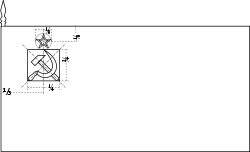
(c) I, Cmapm, CC BY-SA 3.0
The flag of the Soviet Union (1955-1991) using a darker shade of red.

Flagge des Vereinigten Königreichs in der Proportion 3:5, ausschließlich an Land verwendet. Auf See beträgt das richtige Verhältnis 1:2.
Flagge des Vereinigten Königreichs in der Proportion 3:5, ausschließlich an Land verwendet. Auf See beträgt das richtige Verhältnis 1:2.
Flag of Italy from 1946 to 2003, when exact colors were specified.
Flag of the Socialist Federal Republic of Yugoslavia (1946-1992).
The design (blazon) is defined in Article 4 of the Constitution for the Republic of Yugoslavia (1946). [1]
Flag of Second Polish Republic and later People's Republic of Poland in period from March 29, 1928 to March 10, 1980. Red shade used here is HTML "vermilion" #E34234. Proportion 5:8.
Die quadratische Nationalfahne der Schweiz, in transparentem rechteckigem (2:3) Feld.
Flagge Österreichs mit dem Rot in den österreichischen Staatsfarben, das offiziell beim österreichischen Bundesheer in der Charakteristik „Pantone 032 C“ angeordnet war (seit Mai 2018 angeordnet in der Charakteristik „Pantone 186 C“).
Flagge Portugals, entworfen von Columbano Bordalo Pinheiro (1857-1929), offiziell von der portugiesischen Regierung am 30. Juni 1911 als Staatsflagge angenommen (in Verwendung bereits seit ungefähr November 1910).
Autor/Urheber: SanchoPanzaXXI, Lizenz: CC BY-SA 4.0
Flag of Spain during the Spanish State. It was adopted on 11 October 1945 with Reglamento de Banderas Insignias y Distintivos (Flags, Ensigns and Coats of Arms Bill)
Autor/Urheber: SanchoPanzaXXI, Lizenz: CC BY-SA 4.0
Flag of Spain during the Spanish State. It was adopted on 11 October 1945 with Reglamento de Banderas Insignias y Distintivos (Flags, Ensigns and Coats of Arms Bill)
Flag of Australia, when congruence with this colour chart is required (i.e. when a "less bright" version is needed).
See Flag of Australia.svg for main file information.Die Staatsflagge der Deutschen Demokratischen Republik, vom 1. Oktober 1959 bis 3. Oktober 1990
Flagge von Senegal
Olympic Rings without "rims" (gaps between the rings), As used, eg. in the logos of the 2008 and 2016 Olympics. The colour scheme applied here was specified in 2023 guidelines.
Olympic Rings without "rims" (gaps between the rings), As used, eg. in the logos of the 2008 and 2016 Olympics. The colour scheme applied here was specified in 2023 guidelines.
Flag of Second Polish Republic and later People's Republic of Poland in period from March 29, 1928 to March 10, 1980. Red shade used here is HTML "vermilion" #E34234. Proportion 5:8.
Flag of Liechtenstein 1937—1982.
Flag of People's Republic of Mongolia 1945-1992
Flag of South Korea (1949-1984)
Variant version of a flag of Japan, used between January 27, 1870 and August 13, 1999 (aspect ratio 7:10).

